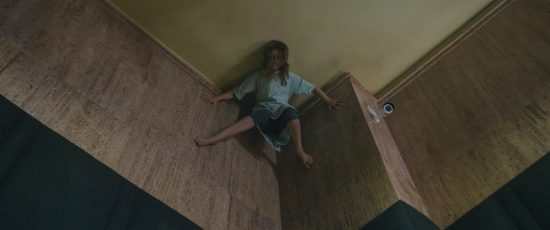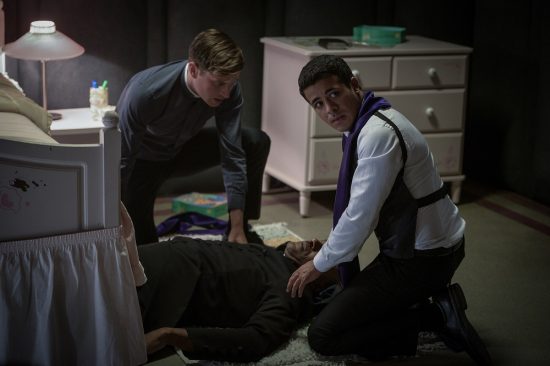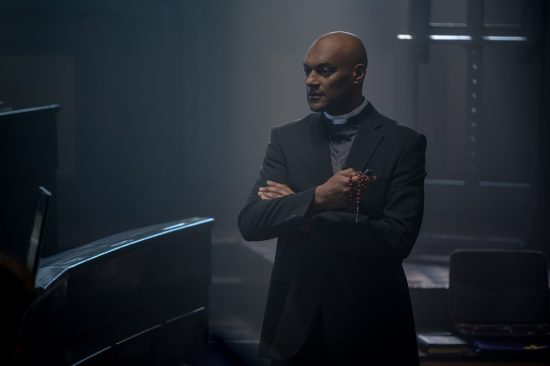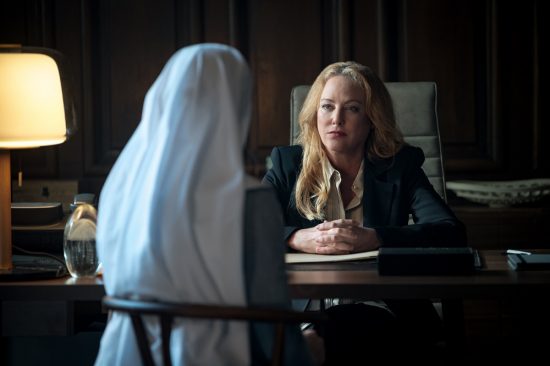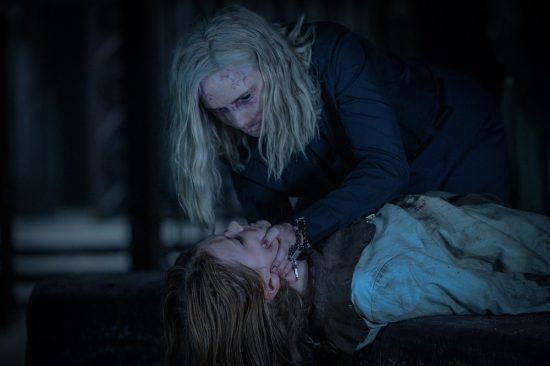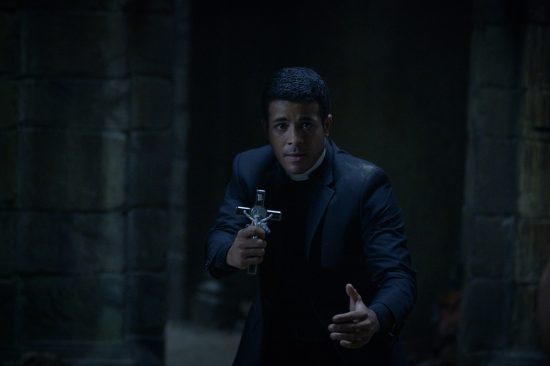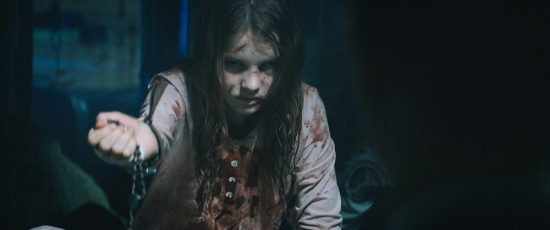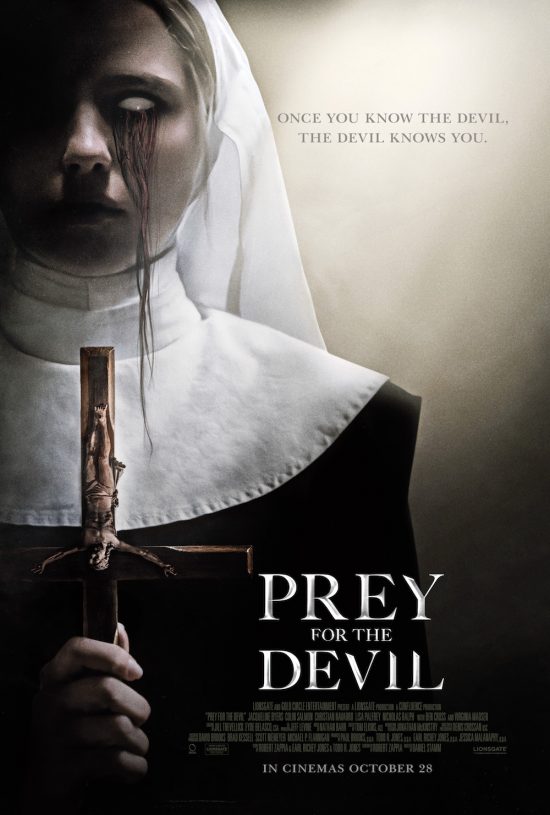Director Daniel Stamm talks to us about Prey For The Devil and The Last Exorcism
Prey For The Devil is out on the 28th of October, just in time for Halloween, and you can read my review here. Being big fans of Daniel Stamm’s previous exorcism-based film, the Eli Roth produced The Last Exorcism, we were keen to ask the director about his latest horror, why he wanted to return to the subject of exorcism, how you craft a scare and what James Wan film he studied to prepare for Prey For The Devil. He even spills the beans on a story about the making of The Last Exorcism that he has never been able to tell before…
Sister Ann (Jacqueline Byers) believes she is answering a calling to be the first female exorcist… but who, or what, called her? In response to a global rise in demonic possessions, Ann seeks out a place at an exorcism school reopened by the Catholic Church.
Until now these schools have only trained priests in the Rite of Exorcism – but a professor (Colin Salmon) recognises Sister Ann’s gifts and agrees to train her. Thrust onto the spiritual frontline with fellow student Father Dante (Christian Navarro), Sister Ann finds herself in a battle for the soul of a young girl, who Sister Ann believes is possessed by the same demon that tormented her own mother years ago. Determined to root out the evil, Ann soon realises the Devil has her right where he wants her.
Prey for the Devil (previously titled The Devil’s Light) stars Jacqueline Byers (Bad Samaritan), Colin Salmon (Alien Vs Predator) and Christian Navarro (13 Reasons Why), with Ben Cross (Star Trek) and Virginia Madsen (Candyman, Designated Survivor). Directed by Daniel Stamm (The Last Exorcism).
Hey, Alan. Good morning!
Hi, Daniel! It’s great to meet you.
It’s good to meet you. It’s 8:20 am in the morning here. So I’m just waking up.
Oh, no! I’m so sorry!
No, it’s good. It’s better than the afternoon when everyone’s asleep and just hanging in there.
I’ve been looking forward to talking to you because we had an absolute blast with Prey for the Devil.
That’s great to hear. Thank you.
We also love your previous exorcism film, The Last Exorcism. What was it about this film that made you want to revisit the subject?
You know what? I didn’t want to do another exorcism movie because I felt like I’d done everything there is to do, with The Last Exorcism, on my ideas to do with the topic.
For about a decade after it, my agents would send me scripts, exorcism-related scripts, and when they did I would call them and say there must be a mistake – this is an exorcism movie. And they said, but you should read this one. THIS ONE IS DIFFERENT.
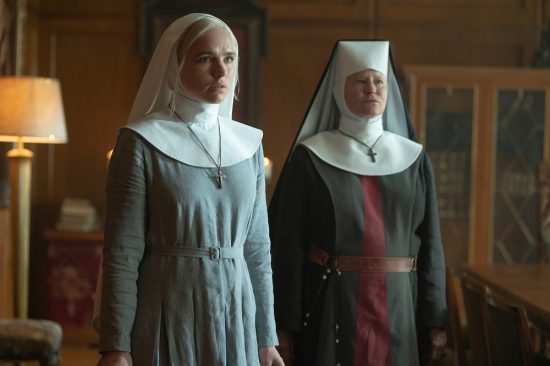
Jacqueline Byers as Sister Ann and Lisa Palfrey as Sister Euphemia in The Devil’s Light Photo Credit: Vlad Cioplea/Lionsgate
Because of Sister Ann?
Yeah, because you have a lead female protagonist you change everything. You’re not just replacing a male character with a female character, you’re telling a completely different story because your sources for conflict are completely different.
With a male protagonist, he is fighting the demon. He has all the support of the church. End of story, kind of thing. With a female protagonist, there is a whole patriarchy that says you can’t come in here. You can’t participate. And she has to fight against that world to even be allowed to perform an exorcism, you know?
And suddenly you need so much more finesse and back story and suddenly it matters so much who is an ally and who is a foe and all these things, and there are so many more stories to tell. I loved that because the strong female protagonist is such a buzzword. Like with most movies you get the feeling that they just took the script that had a male protagonist, they changed the names and now it’s a female protagonist. But that female protagonist is punching the bad guys in just the same way, like in a Marvel movie, but that’s not a strong female protagonist – that’s a female doing the exact same stuff as a man. But here her being female is so baked into the story fundamentally. You could not tell this story with a male priest.
So I loved that about it. The other thing is usually in an exorcism movie you spend forty-five minutes going is this possession? Or not? This movie goes you bought a ticket for an exorcism movie? Guess what? The possession is real. Let’s just cut to the chase here!
(laughs)
Suddenly you now have all this time for these long exorcism sequences that usually you get one of in the third act! Here from the get-go, you have the time to do them and without sacrificing character or story. You have time for all of this because you’ve just been given forty-five extra minutes.
Right, right. So you were like forty-five extra minutes exorcising? I’m in.
Well, how it usually works is they send the script out to like five directors and if you like it you go in with your take. You go into a scary conference room and all the executives are sitting there with stone faces. And you come in with your little PowerPoint and your little song and dance.
(laughs)
Which is weird because in your mind you have already directed the movie as you read the script, you know?
Totally.
So I did this whole thing and it went great and my agents were like they loved it, you’ve got that job, no problem. There’s one more person they’re talking to over Zoom, but get ready because you’ve definitely got it. Then come Friday the other guy got it! The Zoom guy!
(both laugh)
A British director who had done Black Mirror. He got it, I didn’t, I let it go, you can’t get depressed over every single project you don’t get.
So I forget about it, six months pass, I’m at a boardgame convention in Poland and I get a call in the middle of night saying the director had quit and they were one week away from pre-production. Could I be in Romania on Monday?
Then they called two days later and said Romania fell through. Tax credit stuff, could I do Bulgaria? So I went to Bulgaria on Monday and then COVID hit!
BUT suddenly there was nothing but time to work on the script which I wouldn’t have had otherwise. I brought in David Burke to help me with rewrites and the script was already very good and we went from there.
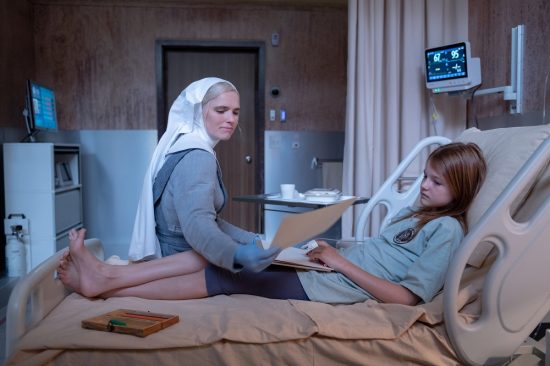
Jacqueline Byers as Sister Ann and Posy Taylor as Natalie in The Devil’s Light Photo Credit: Vlad Cioplea/Lionsgate
Phew. So did the attached cast change at all during the pandemic and lockdown?
You’re touching… Alan, you’re touching on the most painful part of the process for me…
(both laugh)
…because I am such a fan of Jacqui Byers. I think she’s incredible.
Mm-hmm. She’s excellent.
So I want to take credit for finding her so badly, but I had nothing to do with it!
(both laugh)
She was the one thing, the only thing, that trickled down from that director before me. They sent me her tape to look at, like we already have this great actress and the egomaniacal director in me was like well I’m going to hate her, I want to get my own actress, thank you very much. So I click play on the video and… it was the most incredible two and a half minutes of acting I’ve ever seen in my life!
(both laugh) Her supporting cast of Colin Salmon, who I love, and Virginia Madsen, who is an absolute horror legend for Candyman, are fantastic too. What was it like working with them?
They bring a… gravitas.
For sure.
And why that was especially important was because they are representatives of the church. Especially Colin, right? He’s the face of the patriarchy in a way. It’s so easy in these types of movies to portray the church in a one-dimensional way, as very stuck in the middle ages kind of institution and what I loved about the script is our screenwriter Robert Zappia is a practising Catholic, which you never get usually! On The Last Exorcism, there was not a single believer involved in the making of the movie.
Yeah,
But here the script is steeped in catholicism and there is criticism of the church there, sure, but it also gives the church a little bit more credit in that they’re not completely stuck in the past. They are using technology, they are using psychiatry.
Where Virginia’s character comes in.
Virginia’s character is an agnostic psychiatrist who the church has hired on purpose to challenge everything they’re doing.
Colin. The great thing about him was that he portrayed this clergy who on one hand holds the party line of this is how God works, this is how the church works. But on the other hand, he has enough intelligence and empathy to look at this nun and say She should be here because she has talent and maybe it is time for a change in the church.
And that was good too, like earlier you were saying how just saying from the off “demons and exorcism is real” and getting forty-five minutes back, with Colin’s character just having the humility and intelligence to go, You know what, boys, she’s great. As soon as he realises she will benefit the exorcism gang he’s all in and gets her approved and we move on. There’s not ten minutes of hand-wringing and then like one of the students always trying to get her kicked out and all that.
You were saying the writer was a catholic but was there any input from real exorcists?
I just saw, it’s for an extra on our DVD, there’s a feature for it where he interviews a real exorcist and it is mind-blowing. He asked him why women weren’t allowed to do exorcisms and the justification is basically that bishops are the exorcists of any community. They have been given authority because they are like the descendants of the apostles – who were all male. Even that explanation is like a theoretical, philosophical thing. If you’re not battling a demon you very much have the luxury to think like this, but when Colin Salmon’s character is battling a demon with her he doesn’t really care about the semantics! He just wants to survive and she comes in and saves his life, basically. Save his soul. So he has a different angle on the subject matter than the church does – it’s less theoretical!
(both laugh) There are loads of great scares in the movie. What is the secret, directorially, to constructing a good scare in a film?
I think everything in filmmaking is layers. It’s like lasagne. The first thing is your audience needs to care for your protagonist. I think it’s always a huge mistake when a horror film focuses on the scares without having done the character development because people don’t care if you cut someone’s head off if you don’t care for that person.
Right.
Then, talking of cutting stuff up, there’s that theory that if you cut someone’s arm off with an axe you get almost no reaction from the audience, but if you have someone get a papercut the audience goes
(both make wincing sounds)
You get an audible reaction. So, in all horror, in all scariness, if you can keep it relatable, in a way that is only one step away from the audience’s reality then… That’s why I like exorcism stuff so much because it works with so many visceral, nightmarish images. So there’s that. THEN there’s the overall suspense, which is something that is interesting because it’s this like intangible thing that you hope materialises, that you just pray for because it’s the sum of everything you’re doing. It’s the lighting, it’s the architecture, it’s the score, it’s the expression on someone’s face… It’s something that has so many small pieces that on set you almost can’t control it. You can work towards it in every single department but it doesn’t come together until editing.
Yeah.
And that becomes so much about rhythm and every single frame is a twenty-forth of a second and even a single one can make a huge difference. Sometimes a jumpscare does not work and then the editor shows you something and it suddenly works and you go It works! What did you do? And he’ll go I took out two frames. You know?
Did you watch any particular other horror or exorcism films prior to shooting for inspiration?
Before I did this movie, I thought I’d better refresh my horror knowledge, so I watched The Conjuring? By James Wan?
Oh, yeah! His like scare craft is next level.
I sat down with a piece of paper and a pen and was going to take notes about all the techniques he’s using. And then when I was done I had written down two things!
(both laugh)
One was It’s scary when the audience does not witness something that is happening off-screen, which is like Annabelle, for example, is just sitting there and we go inside and when we come back the doll has written a letter. That is scary because now I have to imagine and fill in how this doll wrote this letter.
(laughs) Right.
And the other one was just “Sound”. Jumpscares are 99% sound, so you have to create a moment that justifies blasting a loud sound at the audience and they will jump. You know that they will jump. The difficult thing is to make sure that they then afterwards don’t feel betrayed because intellectually they think the film did not earn this jumpscare.
One of the things that caught us off-guard a lot in the film is that you often go that little bit further, or that little bit nastier than we’re expecting the limit to be…
That is the biggest compliment that you could ever give me! Because people are thinking that 15 is watered-down, but I think it’s different. When I have an R-rated (18) story, I can do so much with gore and splatter and all that other stuff that if you take that away I have to think how do I substitute it? How do I make it scary in a psychological way? So to me, PG-13, 15, it’s not less scary, it’s scary in a different way. An R is almost lazy to me! It would be easier! It would be so much easier for me to do the R-rated version of this. With 15 I have to make it scary without the splatter AND to try and get away with as much as possible.
Coming back to The Last Exorcism – which we’re big fans of in our house – are there any stories about making that film that you’ve always wanted to tell but haven’t and would share with us now?
Well, that is… that is a great question! And my initial thing is there is not a single story about that film that I have not told a million times, BUT the ending originally was different.
Ooooooh.
The ending… I couldn’t talk about it back then. I couldn’t say I screwed up the ending. The studio would kill you if you did that. But in the script… I’ll assume anyone reading this has seen The Last Exorcism…
It’s been like ten years. I think we’re OK. (SPOILER WARNING FOR A TWELVE-YEAR-OLD FILM)
At the end they all run into the forest, they see the shadow and hear the sound of the big demon and the movie as it is right now they all get killed and that’s the end of the movie. In the original, and also what we shot, they didn’t get killed. They come back out and the last scene is of our preacher who is like a fraudster and has talked us through all these little techniques that he has to fake demon possessions that he can then exorcise, he is back in his church and there are thousands of people there, he’s become a legend in the evangelical movement because he has caught a demon on video, which is just shadow and light and sound and all the stuff that he has taught us in small – all his tricks – but now it’s a big thing. And we were supposed to end on this feeling of Wait a minute… did we just witness his biggest PR trick and we fell for it?
Ohhhhh.
And I loved that so much, and it was the whole reason why I wanted to make the movie!
(both laugh)
Because you basically come out of the movie and you don’t even know if you’ve seen a horror movie because there might not have been anything supernatural. And the idea was that the audience comes out of the theatre and the believers say I just saw a demon and the cynics say I just saw a movie about religion being used for financial gain. You know?
Wow.
I thought that was the greatest thing and we shot all that, it was the most expensive scene in the movie, of course(!). Hundreds of extras, the green screen of the demon, all that stuff, and I show it to ten people and one of them goes That is the greatest ending I have ever seen to any movie ever and nine go We have no idea what just happened.
Oof.
And I learned that you can ask a question and not answer it, but there can’t be ambiguity on the question that they’re supposed to ask. So then the studio came back in to change the ending and suddenly everyone’s ideas are on the table and everyone’s like My cousin said that so and so and I kind of panicked and I grabbed the idea that was the least terrible of all of them and that’s the ending that’s in the movie right now. We tried to plant seeds to it earlier like with the girl’s pictures.
Her drawings, yeah.
And we had half a night to shoot all that stuff. All the running into the woods and getting your head chopped off and all that is all reshoots. People either love it or hate it and I always feel like it doesn’t quite fit with the rest of the film, so I’m very proud of 98% of The Last Exorcism, and then the ending, which is the most important thing, I just wish we could have given the world the original ending because I think that it went with the movie much better. That’s the story I was never allowed to tell, obviously, back then, but that I can tell now.
Amazing. Thanks so much for sharing that with us.
No, thank you very much.
It’s been a pleasure to chat to you today and I hope the movie does really well so we can get more Sister Ann versus evil movies.
Oh, that’s right! That would be lovely! Thanks so much, Alan.
Prey for the Devil is in cinemas on 28th October.

